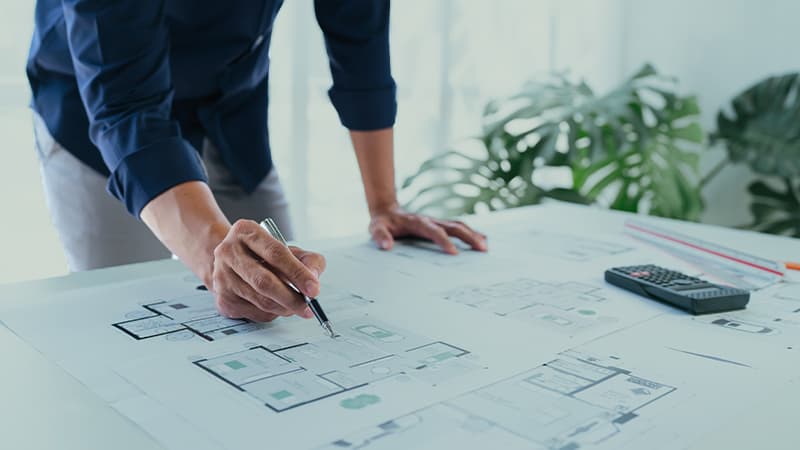Recognizing the Diverse Profession Paths Available for Aspiring Architect
As an ambitious Architect, you have a globe of job courses awaiting you. Each course provides special difficulties and opportunities to apply your creative thinking and technical know-how. Whether you're attracted to standard design or the subtleties of lasting style, there's a particular niche that lines up with your rate of interests. Comprehending these varied options can form your specialist journey, but which instructions will you pick to check out first?
Typical Style: Designing Frameworks and structures
Standard design focuses on making structures and frameworks that blend performance with visual charm. Your layouts can reflect social heritage, showcasing regional traditions while fulfilling modern needs.
You'll establish skills in preparing, model-making, and website evaluation, permitting you to visualize and communicate your concepts properly. Involving with customers, you'll require to recognize their vision and equate it into viable styles.
In addition, constructing codes and sustainability methods are crucial in your work, guaranteeing your frameworks are ecologically friendly and secure. As you grow in your career, you'll find opportunities in domestic, business, and even repair tasks, each offering unique difficulties. Accepting traditional style leads the way for a meeting career that pays tribute to the past while shaping the future.
Urban Preparation: Forming Neighborhoods and Public Spaces
As a hopeful Architect, you can play a crucial duty as a metropolitan planner, changing how areas communicate and work. By utilizing neighborhood interaction strategies, you'll guarantee that homeowners have a voice fit their environment. And also, incorporating sustainable design concepts will certainly aid produce rooms that not only satisfy today's requirements however also safeguard the future.
Duty of Urban Planners
While lots of may think of architects as the single enthusiasts behind structures, metropolitan planners play a vital function in forming the more comprehensive landscape of communities and public areas. By teaming up with different stakeholders, you'll aid make parks, transport systems, and domestic areas that promote social communication and accessibility. Your competence in spatial design and area dynamics permits you to envision future growth while preserving cultural heritage.
Community Interaction Techniques
Efficient area involvement techniques are vital for city planners to assure that the voices of citizens are heard and valued in the preparation procedure. To promote meaningful dialogue, you need to focus on open forums and workshops where area participants can share their concepts and worries. Use surveys and social media sites to reach a broader audience, making certain diverse viewpoints are included. Teaming up with neighborhood companies can boost count on and assist in deeper links. It is essential to provide clear info about decision-making procedures and proposed projects, permitting homeowners to feel enlightened and encouraged. By proactively integrating and listening comments, you'll develop rooms that show the community's demands, ultimately bring about even more sustainable and successful urban environments. Accept openness and constant discussion for long lasting influence.
Sustainable Design Concepts
When making city spaces, including lasting design concepts is essential for producing environments that grow both environmentally and socially. Take into consideration incorporating eco-friendly areas, like gardens and parks, to enhance biodiversity and enhance air top quality.
Creating with water preservation in mind is additionally crucial-- think of rain yards and permeable surface areas to take care of stormwater. Including neighborhood participants during the planning process warranties that the rooms you produce fulfill their needs and urge social interaction. By embracing these concepts, you'll add to vibrant, lasting city landscapes that profit every person.

Landscape Architecture: Creating Lasting Outdoor Settings
As you check out landscape design, you'll discover important layout principles that create gorgeous and useful outdoor areas. Lasting methods play an important function in making certain these atmospheres flourish while minimizing environmental effect. And also, you'll discover a variety of occupation opportunities that permit you to make an actual difference in exactly how people communicate with nature.
Layout Concepts in Landscape
Comprehending design principles in landscape design is crucial for producing lasting outside atmospheres that balance with nature. You'll require to ponder aspects like equilibrium, range, and percentage to guarantee your designs really feel cohesive and welcoming. Additionally, pay attention to seasonal modifications, developing with materials that enhance the surroundings year-round.
Lasting Practices Review
Lasting practices in landscape design not only concentrate on visual appeals however likewise focus on environmental health and source preservation. You can design spaces that advertise dirt health, such as utilizing organic materials and practicing permaculture concepts. Ultimately, these practices ensure your layouts benefit both individuals and the atmosphere for years to come.
Career Opportunities Exploration
With a strong structure in sustainable practices, landscape architecture supplies a variety of job paths that enable you to make a meaningful impact on the environment. Urban planners usually team up with landscape engineers to produce eco-friendly areas in city settings, boosting city visit homepage livability. If you're passionate concerning education and learning, take into consideration ending up being a landscape architecture instructor, inspiring future generations.
Lasting Style: Concentrating on Eco-Friendly Practices
As you discover your career in style, embracing environment-friendly practices can set you apart in an affordable field. Lasting design concentrates on developing buildings that decrease environmental impact while boosting occupant well-being. By incorporating eco-friendly products, energy-efficient systems, and lasting building strategies, you'll contribute to a greener future.
Beginning by getting expertise of environment-friendly accreditations like LEED or BREEAM, which can bolster your qualifications. Think about just how natural light, ventilation, and thermal performance can enhance layout. Team up with designers and environmental experts to introduce solutions that lower waste and conserve resources.
Do not fail to remember the significance of neighborhood involvement-- appealing local stakeholders can motivate styles that balance with the atmosphere. As clients increasingly focus on sustainability, your know-how in environment-friendly techniques will certainly not only draw in jobs however also meet your passion for responsible architecture. Embrace this essential aspect of the occupation, and see your occupation flourish.
Historic Preservation: Shielding and Restoring Social Heritage
While you commence on your architectural trip, take into consideration the essential duty of historic conservation in keeping our cultural heritage. This field concentrates on the protection and restoration of considerable buildings, websites, and structures that tell the tales of our past. By involving in historical preservation, you'll aid secure the architectural heritage that shapes area identity.
As a historic conservation Architect, you'll assess historical importance and analyze the problem of structures. You'll function carefully with preservationists and chroniclers to ensure authentic restoration strategies are utilized. This career course allows you to mix imagination with research, allowing you to develop solutions that appreciate initial products and workmanship.
Your work not just adds to sustainability by reusing existing buildings yet likewise promotes a feeling of pride within neighborhoods. Accepting this course will aid you end up being a guardian of background, protecting the tales and aesthetic appeals that enrich our lives.
Interior Design: Enhancing Indoor Spaces
Historical conservation and interior design both share a dedication to enhancing the developed setting, but they focus on different elements. While historic preservation emphasizes preserving a structure's historical and social value, indoor design zeroes in on optimizing indoor spaces for functionality and visual appeals.
As a hopeful Architect, you'll find that indoor architecture enables you to blend creative thinking with technical abilities. You'll design rooms that not only look good but also advertise convenience and efficiency. This area includes comprehending exactly how light, shade, and products interact within a room, affecting state hop over to these guys of mind and functionality.
You'll function on different jobs, from domestic homes to business workplaces, making certain that each environment meets the demands of its owners. By focusing on user experience, you can transform interiors right into practical and inspiring rooms, making a significant impact on how individuals engage with their surroundings. Accept the chance to enhance interior atmospheres and shape the means people function and live.
Industrial Style: Merging Functionality With Visual Appeals
Commercial layout plays an essential role in developing items that perfectly blend visual appeals with performance, making certain that what you utilize daily is not only visually appealing but also practical. As an aspiring Architect, you can engage on your own in this area, concentrating on developing everything from furniture to consumer electronics. Your job entails comprehending user needs, materials, and manufacturing procedures, allowing you to develop ingenious services that boost everyday experiences.
In industrial style, you'll frequently work together with marketing professionals, designers, and makers, ensuring that your designs are not just beautiful however likewise practical. You'll discover to balance form and function, focusing on functionality without giving up style. By refining your abilities in mapping out, 3D modeling, and prototyping, you'll be fully equipped to bring your concepts to life. This career path provides a vibrant setting where imagination fulfills functionality, making it a rewarding you can find out more option for engineers interested in shaping the products of tomorrow.
Frequently Asked Concerns
What Educational Accreditations Do I Need to Come To Be an Engineer?
To become a designer, you'll need a specialist degree in architecture, typically a Bachelor's or Master's. Furthermore, you'll have to finish a teaching fellowship and pass the Architect Registration Examination to practice legitimately.
Are There Accreditation Needs for Various Building Career Paths?
Yes, there're accreditation requirements for different architectural paths. Architect. You'll need to pass exams, full teaching fellowships, and in some cases pursue specialized training, relying on your chosen emphasis, like landscape design, urban style, or historic conservation
What Software Application Abilities Are Vital for Architects Today?

Just How Can I Gain Practical Experience While Examining Architecture?
You can obtain sensible experience by interning at building companies, participating in layout competitions, volunteering for community jobs, or collaborating with schoolmates on real-world assignments. These possibilities improve your skills and develop useful connections in the industry.
What Task Opportunities Exist Outdoors Typical Style Firms?
You can discover different work chances outside conventional style firms, like metropolitan preparation, indoor design, landscape design, building and construction management, property growth, or perhaps functions in sustainability consulting. Each offers one-of-a-kind difficulties and rewards.
Whether you're attracted to traditional style or the subtleties of lasting style, there's a specific niche that straightens with your interests.When creating urban rooms, integrating lasting style principles is vital for creating atmospheres that thrive both environmentally and socially.As you check out landscape style, you'll discover necessary design concepts that create attractive and functional exterior rooms.Comprehending layout principles in landscape design is important for developing sustainable outside settings that balance with nature.In commercial layout, you'll usually collaborate with marketing experts, designers, and producers, guaranteeing that your styles are not just beautiful yet likewise practical.